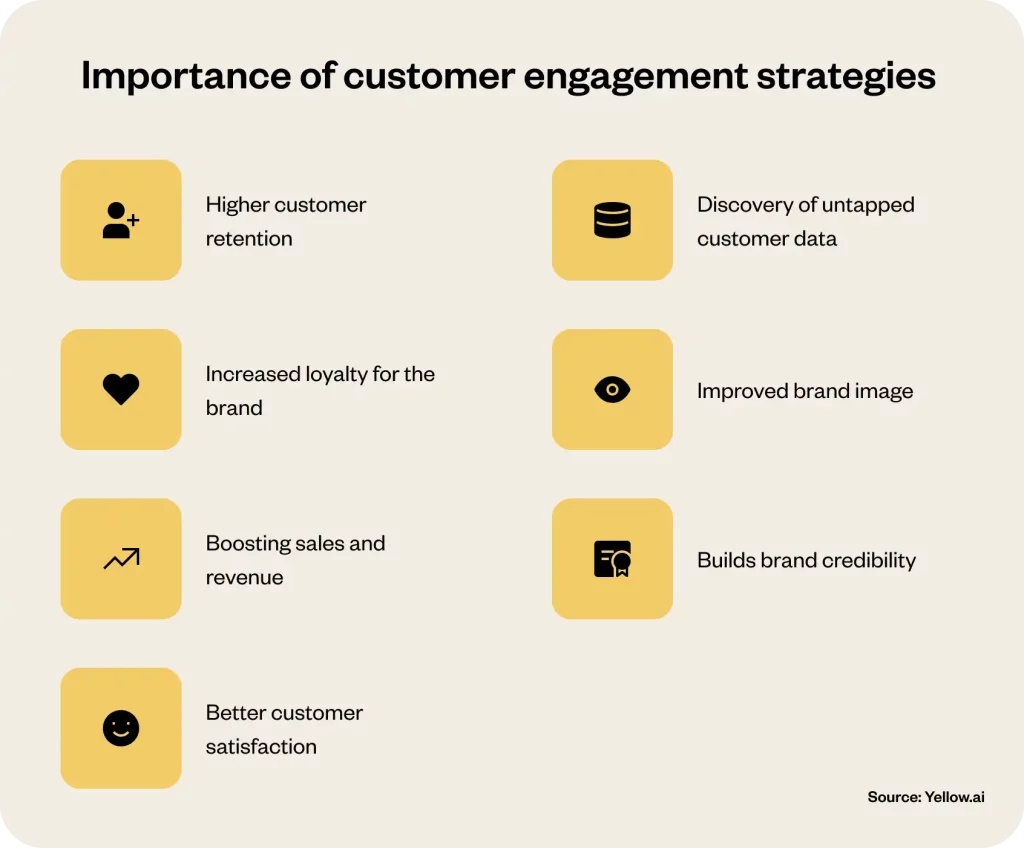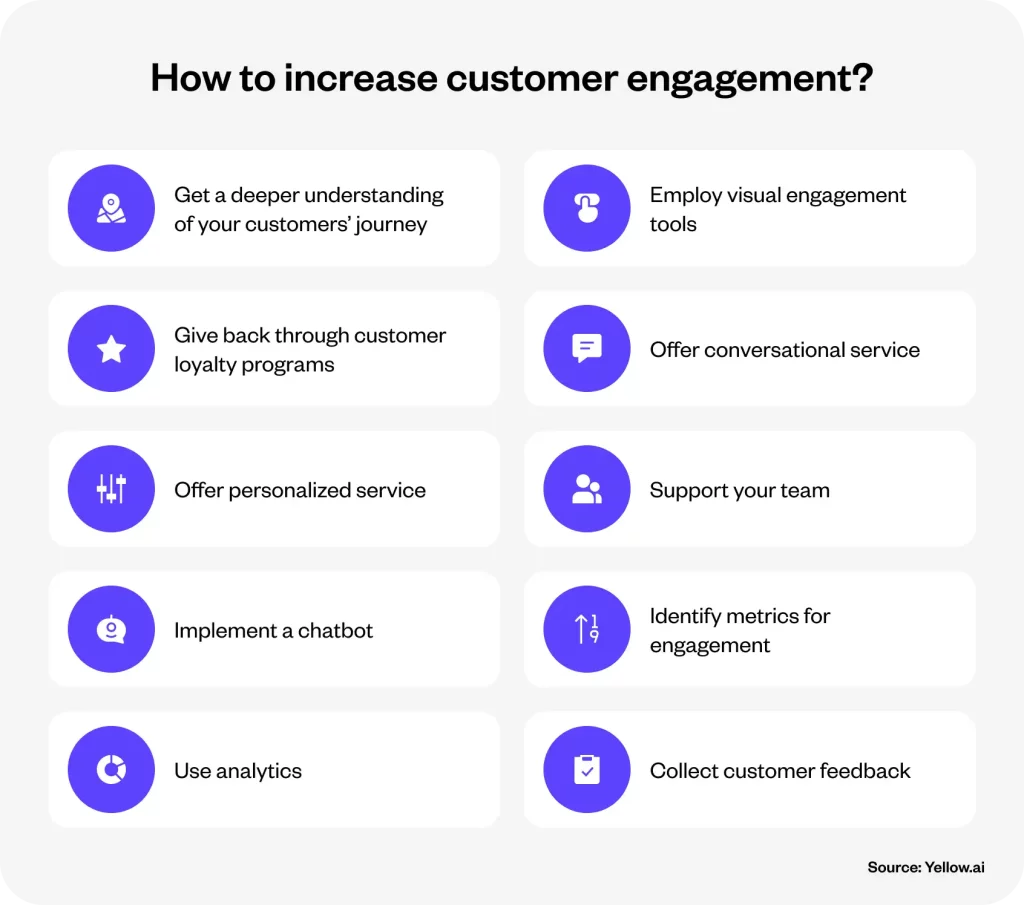In today’s ever-evolving business landscape, customers have an edge, thanks to the options of plenty at their disposal. It has put the question ‘how to increase customer engagement’ at the pedestal for businesses across the industries. Successfully selling a product or closing a deal isn’t enough. To sustain the momentum, brands, companies, or organizations need to reconsider one-time sales merely as the end task. It may earn them customers, but to retain them, efforts are imperative. This is where the importance of engaged customers emerges. From forming the foundation of a thriving business, higher retention rates, enhanced spending power, and tenacious brand loyalty, customer engagement goes a long way.
Its significance applies to every sector: retail, real estate, health, or hospitality. This comprehensive guide delves into the meaning and nuances of customer engagement, exploring its effectiveness and proven strategies of how to increase customer engagement, while giving glimpses of the latest trends shaping the future of customer interactions. Stay hooked till the end of this blog, as the FAQs will answer further queries, giving you a prowess over customer engagement.
What is customer engagement?
The meaning of customer engagement has several layers. It goes beyond simply a technique to scale how the customers connect with your brand at the omnichannel level. While it considers ongoing customer-brand engagement and interactions, it also acts as a blanket term covering numerous touchpoints. Often, many confuse it with customer experience. However, the latter is a part of the former and doesn’t stand in isolation.
Related must-read:
- 7 Proven strategies to improve customer engagement!
- AI chatbots for customer engagement
- A guide on omnichannel customer engagement
Customer engagement applies to an array of processes employed to generate initial awareness, build and uphold customer relationships, post-sale interactions, resolve customer problems, and so on. Engaged customers actively partake in the brand’s ecosystem, indicating a deep connection and loyalty that surpasses mere transactions. Suppose you, as a brand, have a client or a buyer who buys your product or service, sticks to your brand, participates in various activities and loyalty programs, interacts actively, shares reviews and testimonials and, when needed, works as an ambassador of your brand. In that case, you have significantly succeeded in achieving enhanced customer engagement.
To increase customer engagement, an enterprise must create value through the best product or service, extend excellent after-sales support, and ensure effective communication channels for customers. By making the customers experience that they are seen, heard and felt, the brand strikes a strong emotional chord. Let’s learn about some ways businesses like yours can achieve just that.
Importance of customer engagement strategies
It is an understatement to say that a company or business organization must comprehend the importance of customer engagement strategies to have sustained success. Thus, investing time, money, knowledge and resources to devise and implement customer engagement strategies is necessary. When done correctly, businesses are bound to reap incredible benefits.

Here are some of the key advantages:
1. Higher customer retention:
When brands succeed in robust customer engagement, the scope of getting higher customer allegiance is greater. This will ease the task of customer retention. The value of retaining buyers in today’s cutthroat competitive market is priceless.
2. Increased loyalty for the brand:
Customer engagement, as mentioned earlier, goes beyond one-time sales. It is an ongoing process of building and nurturing customers’ loyalty toward the brand. Engaged customers feel connected to the brand and tend to be repeat buyers as well as refer the brand to others.
3. Boosting sales and revenue:
Once customers feel engaged, they are most likely to spend more money on the products and services of the brand over their lifetime. In the process, it will contribute to higher revenue and profitability.
4. Better customer satisfaction:
Through increased customer engagement, customers feel engaged with the brand and thus valued and treasured. It leads to their enhanced satisfaction levels and positive reviews for the brand. It builds their trust.
Related read: How To Improve Customer Satisfaction?
5. Discovery of untapped customer data:
Advanced technologies like AI chatbots enable brands to actively engage with customers, uncovering deep insights into their preferences, needs, and challenges, thereby helping them refine their offerings and enhance overall customer engagement in ways that were once challenging.
6. Improved brand image:
Often, businesses spend a lot in building and sustaining their brand reputation and image. But the good news is, if they succeed in better customer engagement, the latter turn into brand advocates, boosting your business through word-of-mouth publicity and social proof.
7. Builds brand credibility:
Engaged customers get to know the brand’s ins and outs as they actively interact with and for it. They comprehend they are not merely data but the most prized assets for the company. It creates a strong sense of brand credibility.
How to increase customer engagement?
So far, we have discussed the meaning and importance of customer engagement applicable to almost every sector. Meticulously chalking out and implementing strategies will help you find solutions for how to increase customer engagement. It needs a holistic approach. Here are some essential and effective methods to consider:

- Deeper understanding of your customers’ journey
- Customer loyalty programs
- Offer personalized service
- Implement a chatbot
- Use analytics
- Employ visual engagement tools
- Offer conversational service
- Support your team
- Identify metrics for engagement
- Collect customer feedback
1. Get a deeper understanding of your customers’ journey
As a brand, you must be aware and understand your customers’ journey. The process begins with having initial awareness about a potential buyer to post-purchase interactions with a successfully converted customer. It is vital for tailoring strategies. To better serve your customers, you need to map their journey through your business, pinpoint the moments of contact where they feel the most valued, and strive to enhance those experiences.
Related read: What Is a Customer Journey Map and How to Create
Did you know with Yellow.ai’s User Lifecycle Optimizer, you can:
- Create a customer’s lifecycle with different stages, define user actions and expected goals for each stage and generate campaigns that are sure to get a user’s attention in minutes!
- Improve conversions by 50% with AI optimizer
- Boost customer engagement by 60% by running tailor-made, goal-oriented campaigns for each user campaigns across the right channels.
2. Give back through customer loyalty programs
Everyone likes to feel acknowledged and rewarded. You can improve the way customers engage with your brand by rewarding their loyalty and thus fostering lasting connections. Get customers to buy from you repeatedly by instituting a customer loyalty program. Reward loyal consumers with unique perks, discounts, and early access to new product or service launches to make them feel more integral to the company.
3. Offer personalized service
No one likes a one-size-fits-all approach, especially when they have displayed a sustained affinity to your brand. Thus, treat them as individual entities by offering tailored service and interaction for enhanced engagement. Personalize the customer experience by collecting information and insights into their personal penchants. Use this data to customize messages, product suggestions, and offers, letting consumers know they are understood.
4. Implement a chatbot
Today’s advanced business interaction with potential buyers or clients has evolved beyond imagination. One of the significant credits goes to embracing AI-powered channels to communicate. Thus, incorporating a chatbot is an impactful strategy to increase customer engagement for your brand. It can streamline many facets, starting from extending 24/7 customer support and answering frequently asked questions.
Related must-reads:
- How to create a chatbot – Best practices to follow in 2023
- 9 Real life chatbot examples [well-known brands]
- Chatbot design – How to design a successful chatbot?
5. Use analytics
Tracking and measuring customer engagement metrics, such as website traffic, social media engagement, CTR and impression, and customer churn rates, are imperative. You can do it by leveraging data analytics. Once you gather all these insights, you can quickly spot the areas for improvement and optimize your customer engagement strategies.
6. Employ visual engagement tools
To capture attention and convey value, you, as a company with a digital presence, must incorporate visual elements such as immersive videos, infographics, and interactive visual content. It will also enhance customer engagement and make even complex information more digestible. Visual content has the edge over other forms of engaging, disseminating and boosting brand recall.
7. Offer conversational service
Today’s aware customer prefers seamless interactions across various channels of a brand. Offer conversational service options beyond traditional channels like phone and email. Consider using live chat, messaging apps, and social media platforms to connect with customers more personalized and engagingly, adapting to their preferred communication channels.
8. Support your team
Empower your CSE team to function as effective customer engagement champions. They need to be equipped to provide outstanding service and handle customer concerns. You can do this by giving them the training, tools, and authority they need. A customer-centric culture may be built by investing in your team’s competencies, which drives engagement across the company.
9. Identify metrics for engagement
It is also a must for a brand to identify metrics for engagement, as it helps measure success and drive continuous improvement. Find out how engaged your customers are by setting clear and quantifiable KPIs. Net promoter scores, customer satisfaction ratings, social media engagement, and website traffic are all examples of possible measures. Keep an eye on these indicators and examine them often to see how well your customer engagement techniques work and where you can modify them.
10. Collect customer feedback
Get the word out to customers regularly by polling them, reviewing their experiences, or surveying them through social media. By responding to customer feedback in this way, brands show that they care about their opinions and recommendations, which in turn makes customers feel appreciated. It is effective as a method of engaging customers.
How can Yellow.ai help level up your customer engagement?
Yellow.ai is at the forefront of helping businesses like yours to increase customer engagement effortlessly. As we know, today’s customers prefer personalized interactions to get engaged with a brand, and they are inclined towards ease, be it for posting an initial query or resolving an issue. While a robust human resource for customer engagement has its perks, certain limitations can range from their promptness, availability, accuracy, etc. This is when businesses can choose from an array of options provided by Yellow.ai to engage with the customer and retain it.
Omnichannel AI automation: As a brand, you can now unify the customer experience using Yellow.ai omnichannel AI automation. Also, it lets you leverage the context of interactions across channels, which is great for both customers and employees. Facilitate highly customized, immersive experiences with your consumers over 35+ channels.
AI voice agents: You can increase customer engagement by using Yellow.ai voice AI agents who are proficient at responding promptly and correctly. Take personalized communication with your customers to the next level by making them experience human-like interactions. Besides sounding like humans, our AI voice agents can interact in over 135+ global languages. They also use demographics to set the tone and dialect. Maximize savings, speed time-to-market, and provide 24/7 customer service. Thanks to our advanced Automatic Speech Recognition (ASR) technology. Clubbed with our Dynamic NLP™, it helps interpret user intent accurately.
Dynamic Automation Platform (DAP): It has been seen that brands with data-driven insights and analysis of their customers score better in engaging with the latter. In this context, you may use our Dynamic Automation Platform (DAP) to get relevant customer data from key conversational AI metrics like goal completion rate (GCR), deflection rate, CSAT, first reaction time (FRT), and more.
AI-powered User Lifecycle Optimizer:We agreed that companies must comprehend and enhance customer lifecycle journeys. In addition to boosting customer engagement, it helps the business propel expansion. The Yellow.ai User Lifecycle Optimizer is an AI-powered generative tool. With its help, you may automate user-specific lifecycle campaigns that aim to convert them at every touchpoint throughout the purchase process.
With such tools, products and services offered by Yellow.ai, you can increase customer engagement. Evaluating your needs and goals, you may choose what helps in achieving them.
Hyundai boosts revenue and improves customer service with AI automation

Conclusion
In today’s digital age, forging strong connections with customers isn’t just beneficial; it’s crucial for a brand’s survival and growth. In this competitive market, firms must actively connect with customers rather than just exist online. A successful company relies on engaged consumers who are loyal, influential, and brand advocates. In this comprehensive blog, we’ve covered the importance of customer engagement, powerful strategies, and cutting-edge trends that are changing consumer interactions. Using these proven tactics, businesses can create exceptional experiences that foster loyal patronage and long-term growth. By understanding the customer experience and using technology, firms can foster a culture of involvement beyond transactions.
With the foray of AI-powered chatbots and other next-gen conversational AI tools, expect a significant shift in customer engagement as it evolves. Innovative technology, changing customer expectations, and new communication channels will drive this revolution. Businesses must identify and embrace these transformational trends to survive and flourish in the ongoing upheaval. Enhanced customer engagement requires constant focus and proactive interaction tactics.
To sum it up, how to increase customer engagement – is a perpetual expedition rather than a fixed destination. As your customers’ expectations evolve, so must your strategies. Businesses that stay ahead of these changes, using forward looking technology advancements will not only survive but thrive in this dynamic landscape.
Frequently asked questions (FAQs)
What is an example of customer engagement?
Customer engagement may take many forms, for instance, offering exclusive access to sales and promotions or allowing customers to earn points redeemable for future purchases. Another example is giving your patrons a personalized birthday message and gift voucher. These are a few examples of how customers remain engaged with your company through these initiatives since they get additional rewards.
What are the 5 stages of customer engagement?
The 5 stages of customer engagement are discovery, consideration, purchasing, loyalty and advocacy. In the first stage, to increase customer engagement, you must ensure that your brand is easily discoverable and your rank top in search engines through SEO best practices. Create focused content that meets client wants and preferences during the second or considering stage. The customer decides to buy from your brand in the buying stage. You must focus on customer service and a smooth purchase experience. In the fourth stage, customers become repeat customers and forge brand loyalty. You must keep offering special offers, tailored suggestions, and prompt customer service. A consumer becomes a loyal fan and advocates for your brand in the last stage. This is when you need social proof for a solid brand reputation.
What is the goal of customer engagement?
Strengthening relationships with consumers to encourage loyalty, advocacy, and repeat business are some of the primary goals of customer engagement. It also aids in improving the brand’s reputation by means of social proof, such as favorable reviews and testimonials from pleased consumers. Retaining engaged clients is easy, which, in turn, helps generate revenue.






















